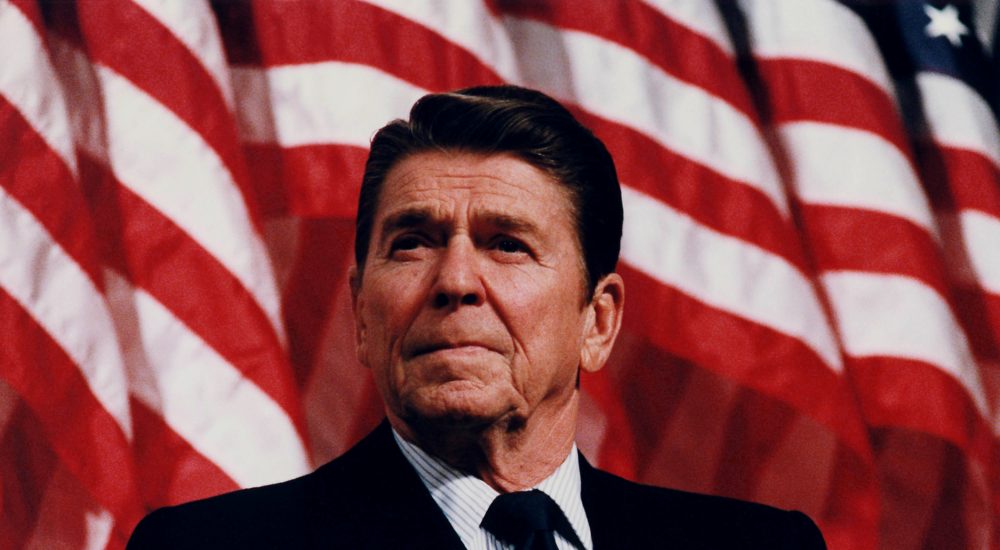35 Years On: Ronald Reagan Announces SDI, or ‘Star Wars’
 For those of us who have reached a certain age, it is hard to believe it has been three and a half decades since President Ronald Reagan introduced the Strategic Defense Initiative, which quickly earned the dismissive sobriquet “Star Wars” (after the George Lucas films of the same name).
For those of us who have reached a certain age, it is hard to believe it has been three and a half decades since President Ronald Reagan introduced the Strategic Defense Initiative, which quickly earned the dismissive sobriquet “Star Wars” (after the George Lucas films of the same name).
Reagan’s introduction was modest and unexpected, coming at the end of a televised address to the nation on the general theme of national security and the defense budget then being considered by Congress.
The Strategic Defense Initiative (or SDI) was not without precedent, however. Winston Churchill had called for defensive weapons systems as early as the 1930s, in the run-up to World War II. One result of the strategic defense debate and subsequent research in that era was radar, which probably saved Britain from total destruction by the Luftwaffe.
There had also been talk about strategic defense from the beginning of the Atomic Age, with pro- and anti- sides alternating pre-eminence from time to time.
In the 1960s, defensive strategic systems were debated and set aside as destabilizing to the doctrine of Mutual Assured Destruction (MAD). As I wrote in the 1986 book, Promise or Peril: The Strategic Defense Initiative (coedited with Zbigniew Brzezinski, Marin Strmecki, and Peter Wehner), U.S. Defense Secretary Robert S. McNamara …
… also rejected a U.S. strategic defense system because it would be easily countered by Moscow. The Soviet Union would be forced to respond with an offensive buildup, which would mean that “the risk of a Soviet nuclear attack would not be further decreased” and, if deterrence failed, “the damage to the United States from a Soviet nuclear attack would not be reduced in any meaningful sense.”
To those following strategic issues in the early 1980s, the substance of Reagan’s “Star Wars speech” was not so surprising, even if the timing of it was. Reagan himself was urged by Edward Teller, known as the “father of the hydrogen bomb,” to promote and initiate defensive systems as part of the overall U.S. national security strategy. Retired General Daniel O. Graham had been pushing a concept he called “High Frontier,” which used off-the-shelf, kinetic technology to knock incoming missiles out of the sky.
In summarizing and introducing an excerpt from Reagan’s SDI speech in Promise or Peril, I wrote:
With President Reagan’s address to the nation on March 23, 1983, the Strategic Defense Initiative became the focus of the U.S. debate over strategic policy. Although much of the speech was devoted to resisting uts in his defense budget, in his conclusion the President offered an alternative to traditional U.S. nuclear strategy. “Wouldn’t it be better to save lives than to avenge them?” he asked. Although “deterrence of aggression through the promise of retaliation” had worked well, Reagan rejected the idea of indefinitely basing U.S. policy on the doctrine of Mutual Assured Destruction.
In calling for this shift, he advocated, not simply a limited defense of U.S. strategic forces, but a total population defense so that “free people could live secure in the knowledge that … we could intercept and destroy strategic ballistic missiles before they reached our own soil or that of our allies.” The President challenged the scientific community, “those who gave us nuclear weapons, to turn their great talents now to the cause of mankind and world peace, to give the means of rendering these nuclear weapons impotent and obsolete.”
The rhetoric of Reagan’s speech echoes that of Winston Churchill … during the British air defense debate of the 1930s.
Thirty-five years on, the Strategic Defense Initiative is no longer front-and-center in discussions of foreign and defense policy. The Cold War ended more than 25 years ago, arguably because of Reagan’s insistence on pursuing SDI. Yet the technologies developed under the SDI umbrella — if under different names and through different specific programs — affect strategic and tactical planning in an era when international terrorism is seen as a greater threat than ICBMs. It certainly affects the approach the United States and its allies in Northeast Asia take toward Kim Jong Un’s North Korea and its nuclear sabre-rattling (and tweets in response to that).
Ronald Reagan’s announcement of what came to be called “Star Wars” was a coda to a routine speech on defense policy, but it came to define a decade.


